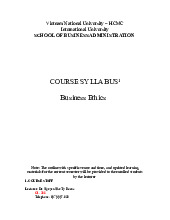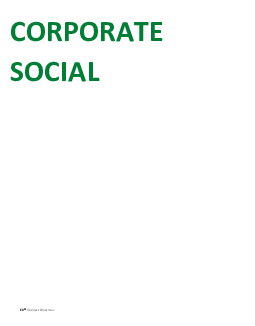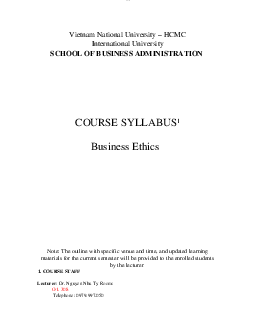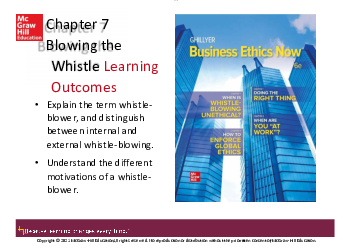














Preview text:
lOMoAR cPSD| 36490632
CHAPTER 1: UNDERSTANDING ETHICS
Understanding those definitions: -
Ethics: Ethics is about how we meet the challenges of doing the right thing when that will
cost more than we want to buy. - Moral. -
The value: determine intrinsic or instrumental value. -
Ethical theories: virtue ethics, utilitarianism, universal ethics, The Golden rule ( theo thầy).
Note: Moral and values = personal principles or perception => value system.
Maint point: 1. Can you find the weaknesses of each theory in ethics? ● Virtue ethics: -
Depend much on the environment or societies => what you want >< what you can do => value conflict. - Individualism.
● Utilitarianism ( ethics for the greater good): -
Focus too much on results ( consequences, benefits => underestimating the
process of the struggle between morality and justice. -
Unjust. For instance, If the happiness of the many is increased enough, it can
justify making one (or a few) miserable in service of the rest. ● Universal ethics: -
Ignores consequences of actions. -
Inflexible: easy to break an unhelpful rule if the situation warrants it. -
Unrealistic: Everyone has a different concept of morality ( ethical value). -
Universal ethics do not apply much due to every situation occurring unique ( each one is different).
2. How can you understand and determine the moral standards? lOMoAR cPSD| 36490632
● It can be effected or created ( collection or influence ) by many factors => build up during
your life => moral compass => make the right decision. ● Moral standards base on: - Friends. - Family. - Ethnic background. - Religion. - Education. - Media. -
Personal role models and mentors ( the most important). 3. Value conflict:
● Everyone has a different “ value” which has “ specific worth” for them. These may
include religious differences, cultural differences or differences in upbringing ( living environment).
● In addition, a different “ value system” leads to conflict.
● When a value conflict occurs, people tend to want to change the other's mind, making
the opponent lose confidence in their choices ( beliefs) and reduce their self-confidence.
● There are some typical value conflict: - Money >< Reputation. -
Equality >< Individualism. -
Competition >< Cooperation.
● Common features that caused value conflict: - Misunderstanding. - Mistrust. -
Strained or poor communication. lOMoAR cPSD| 36490632 - Non-negotiability. - Negative Stereotyping.
CHAPTER 2: DEFINING BUSINESS ETHICS.
● Understand those definition ( vì ã có sẵn trong slide và sách nên mình không nói gì
thêm nha, nếu có gì chưa rõ các bạn có thể hỏi trực tiếp Thầy hoặc mình): 1. Business Ethics. 2. Stakeholder. 3. Oxymoron. 4. Codes of ethics. 5. Series of clichés. 6. Ethical dilemma. 7. Resolution.
Note: Mình lưu ý là các bạn có thể giải thích và trình bày nghĩa các “ terms” này theo ý và cách
hiểu của bản thân nha ( khi thi sẽ có iểm cao h n so với giống từng chữ của ịnh nghĩa trong sách). ● Main point: 1.
Is Business Ethics an Oxymoron? -
Yes ( more on this age): Due to the development of the economy, people want/ need more
money which is a tool for getting what they want. People just focus on how to run their own
business effectively. They choose what they want to do to achieve the highest benefits ( less
costs or optimize resources => more profits). They are aware that the things they do are
wrong ( illegal >< moral ) but it is right, useful for their business. People separate their
personal values from being a client's business. -
No ( which related to “ Code of ethics”): (Vì là ví dụ nên mình nói tiếng mẹ ẻ cho dễ hiểu nha). lOMoAR cPSD| 36490632
Không biết là các bạn có từng nghe về vụ Apple từ chối nhiều lần với ề nghị của FBI chưa dạ?
Tội phạm bị FBI theo dõi và bắn chết có ể lại iện thoại Iphone thì FBI không mở khóa ược nên ã
yêu cầu Apple mở khóa. Nhưng, Apple không ồng ý và nói rằng họ sẽ chỉ cung cấp cho FBI
những thông tin họ ược phép cung cấp của khách hàng và không trả lời bất cứ gì thêm ( mặc dù
2 bên ã trao ổi và họp hành rất nhiều lần). Apple cho rằng nếu họ cung cấp tất cả thông tin và
giúp FBI mở khóa thì ó sẽ là tiền ề làm khách hàng không tin tưởng vào tính bảo mật và quyền
riêng tư khi mua sản phẩm của Apple, hoặc bị kẻ xấu lợi dụng và Apple không thể ảm bảo an
toàn thông tin cho khách hàng => ảnh hưởng xấu ến Apple. Thật ra thì vụ này về sau khi công
bố ã giúp Apple tăng cả doanh thu và danh tiếng. Ở trường hợp này, thì Apple làm úng cả về luật
của công ty và luật của hợp ồng giữa người mua và người bán.
( Nếu là các bạn thì các bạn sẽ chọn ạo ức nghề nghiệp hay chia sẻ thông tin tội phạm và
giúp mở khóa ha?)
This is also the case for the question “ Can business really be ethical?”.
2. The Golden Rule ( widely applied in three resolution principles ): -
The Golden Rule simply states that: “ You must treat others in the same way that you would
want to be treated in the same situation” or “ Putting oneself in someone else’s shoes”. -
Why is the Golden Rule important? How does it apply in business ( ethics) ?
3. Why should people be concerned about “ Doing the right thing” ? -
What is “ the right thing” ? Your beliefs, your right, perception or what you think is fair OR
what everyone does, what they accept ? -
The result of doing the right thing and its effect. -
In ethics, what you do, your behavior defines you.
4. How to solve an ethical dilemma? lOMoAR cPSD| 36490632 -
Step 1: Deeply understand the current situation ( ethical issue) and analyse it. Bước này
nghĩa là bạn xác ịnh loại vấn ề của mình thuộc loại nào ể tìm hướng giải quyết.
Resolution of an ethical dilemma can be achieved by first recognizing the type of conflict you are dealing with: + Truth versus loyalty.
+ Short term versus long term. + Justice versus mercy.
+ Individual versus community. -
Step 2: Identify the alternatives/actions then analyze ( evaluate) to choose the best one.
( Các bạn dựa vào “ clichés” ể quyết ịnh sao cho úng nha). A series of clichés:
+ Consult the Company Code of Ethics.
+ Do what’s right for the Organization's Stakeholders. + Do what’s legal.
+ Do what you think is best (“ use your best judgment”). + Do the right thing. -
Step 3: Make the decision ( use ethical reasoning to resolve the dilemma).
Three Resolution Principles: ( Once you have reached a decision as to the type of conflict
you are facing, three resolution principles are available to you):
+ Ends-Based: which decision would provide the greatest good for the greatest number of people?
+ Rules-Based: what would happen if everyone made the same decision as you?
+ The Golden Rule: “ do unto others as you would have them do unto you”.
Note: Sau khi ưa ra quyết ịnh, các bạn nên ánh giá hiệu quả của nó nha. Kết quả ấy tốt như thế
nào, có ảnh hưởng như thế nào.
Example of ethical dilemma in business: lOMoAR cPSD| 36490632 Case description:
Nurses face more and more ethical dilemmas during their practice nowadays, especially when
they are taking care of the patient at the end of life stage. The case study demonstrates an ethical
dilemma when nursing staff are taking care of an end stage aggressive prostate cancer patient
Mr. T who expressed the suicide thoughts to one of the nurses and ask that nurse keep secret for him.
Ethical dilemma identification
The ethical dilemma is identified as “ if the nursing staff should tell other health care team
members about patient's suicide attempt without patient's consent”. Analysis
To better solve this case and make the best moral decision, the ethical theory, the ethical
principles and the Australian nurses' code of ethics values statement, the associated literature
relative with this case are analyzed before the decision making.
Ethical decision making
After consider all of the above factors, in this case, the best ethical decision for the patient is that
the nurse share the information of Mr Green's suicide attempt with other health care professionals. Results
In Mr Green's case, the nurse chose to share the information of Mr Green's suicide attempt with
other health care professionals. The nursing team followed the self-harm and suicide protocol of
the hospital strictly, they maintained the effective communication with Mr Green, identified the
factors which cause patient's suicide attempt, provided the appropriate nursing intervention to
deal will these risk factors and collaborated with other health care professionals to prefect the
further care. The patient transferred to a palliative care service with no sign of suicide attempt
and other self-harm behaviors and passed away peacefully 76 days after discharged with his
relatives and pastors accompany. lOMoAR cPSD| 36490632
CHAPTER 3: ORGANIZATIONAL ETHICS
Defining Organizational Ethics: - Organizational culture. -
Value chain: For example, the value chain of IU university: a network of activities centered
on the functions of teaching, research, and community service => for students =>
graduation => get jobs, help the society. Note: -
Organization has a lot of functional departments ( which are listed in slide, by your
classmates as well). But, those below are the most commonly used. -
Bên cạnh việc hiểu ược các “ ethical values”, các bạn cũng nên hiểu thêm về các “ ethical
dilemmas ( ethical challenges) của từng “ key function” nha.
Organizational function:
RESEARCH & DEVELOPMENT: -
What are the main tasks or responsibilities of R&D? Where is the source of infor they used?
It carries the responsibility for “ future growth of the organization” => design, calculate the
features of new products, focus on the marketing trend and customer demands, etc. The
infor which is used by market research, customer feedback, etc => organize it => analyze the results. - Ethical values:
+ Ideal of making products: “ better, cheaper, faster ” => meet a targeted cost and benefits figure.
+ Critical commitment to product quality, safety, and reliability. -
Ethical challenges: They want more profits with minimizing the cost but also they are
scared of not attracting consumers and being uncompetitive enough with other companies.
+ “ Do we use the best materials available or the second best to save some money?
Do we run a full battery of tests?”. lOMoAR cPSD| 36490632
+ Whether the research meets the demand of customers/ consumers? Whether they
add high or normal qualities? Add some or only one new feature?
+ Ví dụ: Apple ã ra mắt các dòng Iphone mới từ Iphone 4, 5, 6,...cho ến nay. Họ ã
nghiên cứu và quyết ịnh thời gian rằng khi nào sẽ xuất bản từng loại Iphone mới.
Vậy, vấn ề ở ây là: thay vì làm mới từng chút, hay phát triển từng chút các chi tiết,
tính năng cho từng mẫu iện thoại Iphone và phát hành từ từ từng loại, tại sao họ
không sản xuất một chiếc Iphone tốt nhất, ẹp nhất, chất lượng nhất mà họ có thể vào một ngày nào ó?
=> Có rất nhiều lý do như chi phí không ủ, công nghệ chưa phát triển hoàn toàn,
thời cơ chưa thích hợp, cạnh tranh hoặc họ thật sự có thể nhưng họ không muốn
=> Họ quyết ịnh nâng cấp và làm mới Iphone từng chi tiết theo từng giai oạn
( trending) ể thu hút khách hàng => tăng sản lượng, doanh thu => more profits.
Khách hàng không thực sự tưởng tượng ược thế nào là chiếc iện thoại tốt nhất
cho họ, do ó nhiệm vụ của R&D là tìm hiểu, thử nghiệm và phát triển sản phẩm
=> thu hút khách hàng, tạo niềm tin cho họ về sự phát triển của sản phẩm => tăng
danh tiếng ( reputation, brand image, values). MARKETING: -
Ethical values: Having the responsibility to ensure products reach the hand of satisfied
customers. The marketing process includes PR, advertising, sales promotions. Using the
right advertisement to the right people. -
Ethical challenges: Case “ Overbooking” mình tìm cũng khá rõ ràng rồi. Tuy nhiên, mình
cũng sẽ nói thêm những ví dụ khác cho các bạn có nhiều ý hơn khi làm bài nha.
+ Các bạn lưu ý phân tích ví dụ của bản thân dựa trên “ universal ethics” và “ utilitarianism”.
+ Marketers ( organization, company) want to sell as much as products they can to get
large profits => use tools in the marketing process to increase the selling, attract
customers => use fake news or over slick advertising => attract customers
=> more customers/ consumers believe then buying what they do not really need. lOMoAR cPSD| 36490632
This is also the customers’ psychology called FOMO ( fear of missing out).
+ Personal information or customers’ data are not secret ( insecurity).
+ Ví dụ: Chúng ta ang sống ở thời “ e-marketing economies”, nơi các trang thương
mại iện tử và công nghệ thông tin phát triển. Ví dụ, hôm nay các bạn iền các thông
tin của các bạn trên một trang web ăng kí học IELTS online, thì hôm sau, những
nơi tổ chức dạy IELTS online khác ều có thông tin của các bạn và liên hệ hoặc
quảng cáo dịch vụ của họ cho các bạn. Hoặc, khi các bạn muốn mua và tìm các
mẫu áo sơ mi các bạn thích trên google, thì hôm sau trên
Facebook sẽ hiện rất nhiều quảng cáo của các shop bán áo sơ mi cho các bạn. MANUFACTURING: -
Ethical challenges: “Do you want it built fast, or do you want it built right?”, “ fairness”, “ compromise”.
+ Ví dụ: chất thải từ nhà máy của các bạn gây ô nhiễm môi trường. Các bạn cần nâng
cấp ( lắp ặt mới) hệ thống xử lý chất thải tiên tiến áp ứng yêu cầu của nhà nước.
Tuy nhiên, quá trình này tốn rất nhiều tiền. Đồng thời, công ty của các bạn ang tập
trung nguồn vốn cho dự án sản xuất sản phẩm mới, theo khảo sát và kết quả thử
nghiệm thì khi sản phẩm mới này phát hành sẽ mang lại lợi ích to lớn cho công ty
(cả về lợi nhuận và danh tiếng). Nếu công ty của bạn không sản xuất, thì công ty
ối thủ sẽ cạnh tranh ể sản xuất hoặc sản phẩm của các bạn không còn phù hợp
với nhu cầu thị trường nữa. Vậy, là người quản lý, các bạn cần tập trung cho việc
bảo vệ môi trường ( tiêu tiền cho hệ thống xử lý nước thải => long-term purpose)
và bỏ qua cơ hội tốt nhất ể phát triển công ty hay các bạn sẽ chọn ngược lại ( phát
triển công ty => short-term purpose => “ il egal” nhưng lợi cho công ty trước rồi
hẵng quan tâm ến các vấn ề khác)? HUMAN RESOURCES: -
Ethical values: The relationship between the company and the employees throughout
the contract. It concerns human rights ( labor rights), the safety environment for workers, and policies. lOMoAR cPSD| 36490632 - Ethical challenges:
+ Ví dụ: Gucci ở Thâm Quyến ( Trung Quốc) sử dụng “ The Labor Dispatch system”.
Trong hình thức tuyển dụng này, có nghĩa là Gucci tuyển công nhân thông qua
một bên trung gian, không tuyển dụng trực tiếp. Gucci chỉ có trách nhiệm trả lương
cho công nhân, còn những quyền lợi của công nhân và chi phí khác như tiền bảo
hiểm, tiền ền bù hợp ồng là do bên trung gian - nơi trực tiếp tuyển dụng những
công nhân này chịu trách nhiệm bởi hợp ồng của họ. Mô hình tuyển dụng này ược
áp dụng rộng rãi vì nó giúp tiết kiệm chi phí cho công ty và giảm bớt rất nhiều gánh
nặng trách nhiệm hợp ồng với nhân viên. Kết quả là, Gucci bị tố cáo rằng không
tôn trọng quyền lợi của nhân viên và bóc lột sức lao ộng của họ. Tuy nhiên, Gucci
cho rằng họ ã làm úng theo hợp ồng và các vấn ề khác của công nhân không liên
quan ến trách nhiệm của họ ã thỏa thuận trong hợp ồng.
Note: Các bạn lưu ý, những “ key” : R&D, Manufacturing, Marketing, HR có quan hệ với nhau:
thử nghiệm, thiết kế và phát triển sản phẩm => tạo nên sản phẩm => quảng cáo sản phẩm ra thị
trường. Nhân viên và công ty hòa thuận thì sản phẩm ược tạo ra mới tốt nhất ược.
CHAPTER 4: CORPORATE SOCIAL RESPONSIBILITY
Understanding those definitions: -
Corporate social responsibility ( CSR) = corporate citizenship = corporate conscience. -
Management without conscience: + Instrumental approach. + Social contract approach. - Management by inclusion. -
The driving forces behind CSR: 5 major trends. + Transparency. + Knowledge. + Sustainability. + Globalization. lOMoAR cPSD| 36490632
+ The failure of the public sector. - The triple bottom line: + Financial. + Social. + Environmental. - The CSR bandwagon: + Ethical CSR. + Altruistic CSR. + Strategic CSR. Main point: 1. CSR: -
Target of the organization: social benefit > profits ( include its shareholders) + “ all” legal obligations. -
Stakeholders include: government, employees, customers, suppliers, community
organizations, subsidiaries and retailers, joint venture partners, local neighborhoods, investors and shareholders. -
Carroll’s Pyramid of CSR: ( tháp có chi tiết trong slide và Thầy cũng giảng kĩ rồi nên
mình không nói nhiều cho phần này nha). -
How can businesses make money from CSR ? or How can it benefit business ?
+ Customers who have developed a trust in a company due to its CSR activities are
more likely to resist criticisms of its products and/or activities.
+ The long-term existence and growth: reputation, profits, brand image, trusted, loyal customers, etc. + Professionalisation. lOMoAR cPSD| 36490632
+ Companies that have a responsible CSR approach are better placed to win contracts
or development permission in the environmentally friendly industries from the
government and favorable for future product development activities
=> “ avoidance of government regulations” ( chính phủ thấy doanh nghiệp này có
trách nhiệm với xã hội, không gây ô nhiễm môi trường,... => không hạn chế tự do
của doanh nghiệp ó nhiều, không quá khắt khe khi phê duyệt,...). -
For instance, on Feb 20th, in cooperation with Korea International Volunteer Organization
(KVO), Samsung electronics brought solar-powered LED lanterns to 1,000 homes in a
remote village in Oroma, Ethiopia => social benefits ( charity, encourage people to use
renewable energy sources) => gain reputation + advertising new products.
Note: Các bạn lưu ý, khi công ty áp dụng CSR, không có nghĩa là công ty này làm việc phi lợi
nhuận nha ( it is not a non-profit organization ). Vẫn là trong môi trường cạnh tranh giữa các công
ty ( “ competitive environment”), làm gì cũng phải có “ profits” mới ược, chỉ là khi áp dụng CSR có
nghĩa là họ ặt lợi ích xã hội lên hàng ầu thôi. Những lợi ích này có giá trị to lớn h n và lâu dài h n
cho công ty, nên công ty không ặt nặng vấn ề lời nhiều hay ít tại thời iểm ó nữa.
Bonus: ( phần này các bạn có thể ọc thêm ể có nhiều góc nhìn a dạng h n cho CSR nha, dễ liên
tưởng ý khi làm bài).
Theo bạn, liệu có phải tất cả các bên liên quan trong công ty ều chấp nhận thực hiện CSR hay
không? Nếu không, thì những tranh cãi hay những mặt hạn chế của CSR là gì? -
Doanh nghiệp hoạt ộng trên mục tiêu c bản ( hiển nhiên) là ể kiếm lời, tối a hóa lợi nhuận
của họ và các nhà ầu tư. Họ cho rằng việc quan tâm ến lợi ích của xã hội là trách nhiệm
của chính phủ, không phải của doanh nghiệp. Do ó, họ không cần ưu tiên hay quan tâm quá nhiều về nó. -
Khi doanh nghiệp áp dụng CSR, họ không thể o lường chính xác mức ộ họ có thể can
thiệp, trách nhiệm hay lợi ích mà họ có thể ạt ược => rủi ro, “ unexpected outcomes”. lOMoAR cPSD| 36490632 -
Các quản lý, các lãnh ạo của doanh nghiệp có trình ộ chuyên môn kỹ thuật cao. Tuy nhiên,
có thể họ thiếu kỹ năng và năng lực hay không có năng khiếu ể giải quyết các vấn ề xã hội. -
Các nhà ầu tư luôn muốn thấy “ lời” của dự án ngay lập tức ể họ quyết ịnh có nên tái ầu
tư ể kiếm thêm hay không. Một dự án thành công là khi kết thúc doanh nghiệp có thể lập
tức thấy ược tiền lời nói chung, tuy nhiên CSR cần một khoảng thời gian dài h n, các nhà
ầu tư không muốn ợi “ lời” quá lâu. -
Thông thường, các chi phí liên quan ến các vấn ề xã hội rất cao. Do ó, doanh nghiệp muốn
bù vào chi phí sản xuất thì phải nâng giá sản phẩm lên => khách hàng không muốn mua
nữa do ngại giá cả ( “side effect” ) => “ lời” ít => doanh nghiệp không thể tiếp tục kinh
doanh => các nhà ầu tư nản lòng và không còn hứng thú tham gia vào các hoạt ộng có
trách nhiệm xã hội.
2. Management without conscience: -
The instrumental approach ( Milton Friedman’s): “ The perspective that the only
obligation of a corporation is to maximize profits for its shareholders in the provision of
goods and services that meet the needs of their customers”. -
Ví dụ: Một công ty ầu tư chỉ quan tâm ến lợi nhuận, họ ề ra các iều khoản và các cơ chế
làm việc khác nhau ( như ưu ãi hơn cho các công nhân có hiệu suất cao khi làm việc ) =>
tăng số lượng sản phẩm => tăng doanh thu => tăng lợi nhuận. -
The social contract approach: “ The perspective that a corporation has an obligation to
society over and above the expectation of its shareholders”. -
What is the difference between “ the old social contract approach” and “ the modern social
contract approach” to corporate management ?
The modern social contract approach aims to meet the demands of all stakeholders and
the shareholders, whereas the old social contract approach was based only on economic growth. lOMoAR cPSD| 36490632 -
Social contract approach means the company has an obligation to society, above and
beyond the interest of stakeholders ( external). >< The instrumental approach says the
company's one and only obligation is to maximize profits for shareholders ( internal).
3. The driving forces behind CSR: ( có 5 xu hướng chính ảnh hưởng ến CSR và cũng là
ộng lực ằng sau hiện tượng này).
Note: ví dụ về các “ terms” này ã ược Thầy và các bạn thảo luận rất kĩ trên lớp, nên mình xin phép
không nói thêm, nếu chưa ghi chép lại, các bạn vui lòng xem lại “ record” như thêm một cách ôn
bài giúp mình nhớ bài lâu nha. -
Transparency: “ business actions wil be known around the world”.
=> Nhờ sự phát triển của “ internet” ( và luật pháp), bất cứ chuyện tốt hay xấu mà công ty
làm ra ều có thể bị phát hiện ngay lập tức => công ty không thể tiếp tục che giấu như quá
khứ => vừa có hại và vừa có lợi. -
Knowledge: “ customers have access to more information and ability to act on that info”.
=> Dựa vào “ transparency”, các nhà ầu tư và khách hàng ( người tiêu dùng) dễ dàng cập
nhật thông tin và chú ý tình hình của một công ty => nền kinh tế dựa trên thông tin nghiêm
ngặt => khách hàng ( nhà ầu tư) chủ ộng ánh giá, so sánh, nhận xét và quyết ịnh nên lựa
chọn công ty nào ( thương hiệu nào) ể mua hàng ( ầu tư). -
Sustainability: “ focus on sustainability of earth’s natural systems”.
=> Dân số tăng dẫn ến mức khai thác tài nguyên thiên nhiên quá mức => cạn kiệt nguồn
tài nguyên thiên nhiên ( vấn ề luôn ược quan tâm và tranh cãi) => các công ty chịu áp lực
và buộc phải lập nên kế hoạch với chiến lược thân thiện môi trường, bảo ảm tính bền
vững vì lợi ích của cộng ồng => xây dựng hình tượng tốt cho công ty. -
Globalization: “ many different governments involved with our global business actions”.
=> Sự hợp tác của toàn dân, các công ty ( tổ chức) và chính phủ của các quốc gia khác
nhau => cùng nhau tạo ra một kế hoạch cho tương lai có thể duy trì sự sống trên hành
tinh của chúng ta càng lâu càng tốt. lOMoAR cPSD| 36490632 -
The Failure of the Public Sector to address social problems.
=> Sự thất bại của chính phủ => người dân ( công khai) thể hiện sự thất vọng và mất
niềm tin ối với các chiến dịch của chính phủ ( nói riêng) => tăng áp lực cho các doanh
nghiệp => họ phải hành ộng sau cho vừa có lợi công ty và xã hội, vừa làm hài lòng người dân.
4. The triple bottom line: ( cam kết xây dựng doanh nghiệp bền vững dựa trên 3 tiêu chí, từ
ó giảm thiểu rủi ro khi ầu tư, tăng tuổi thọ và tính bền vững, nâng cao danh tiếng của một
doanh nghiệp toàn cầu). -
Economic ( = profit = financial): Bản chất một công ty bền vững là một công ty có sự bền vững ( ổn
ịnh) về mặt kinh tế ( dài hạn) => tránh việc ham lời ( lợi ích ngắn hạn) mà
gây hại lâu dài => giảm lợi nhuận ( ảnh hưởng xấu) ến công ty không thể cứu vãn ược. -
Social ( = society = people): Cạnh tranh trong kinh doanh là iều không tránh khỏi thậm
chí ược khuyến khích ể thúc ẩy nhu cầu tiêu dùng => tăng trưởng kinh tế. Tuy nhiên, khi
nhìn vào “ big-picture”, một xã hội phát triển tốt hơn là khi mỗi “ cá nhân” ( doanh nghiệp)
cũng phát triển, không thể chỉ ể một công ty duy nhất phát triển vượt bật một mình ( hơi
lý thuyết xíu ha). Trái ngược với “ competitive environment”, iều này sẽ cho phép công ty
tiếp tục tồn tại và nó sẽ thúc ẩy thiện chí giữa công ty và xã hội mà nó tồn tại. -
Environmental: lại là bảo vệ môi trường, tránh khai thác quá mức.
5. The CSR bandwagon: ( Phần này chủ yếu là ở mức ọc hiểu, mọi người có thể ọc thêm trong sách nha).
Document Outline
- CHAPTER 1: UNDERSTANDING ETHICS
- Ethical dilemma identification
- Analysis
- Ethical decision making
- Results
- CHAPTER 3: ORGANIZATIONAL ETHICS
- CHAPTER 4: CORPORATE SOCIAL RESPONSIBILITY




